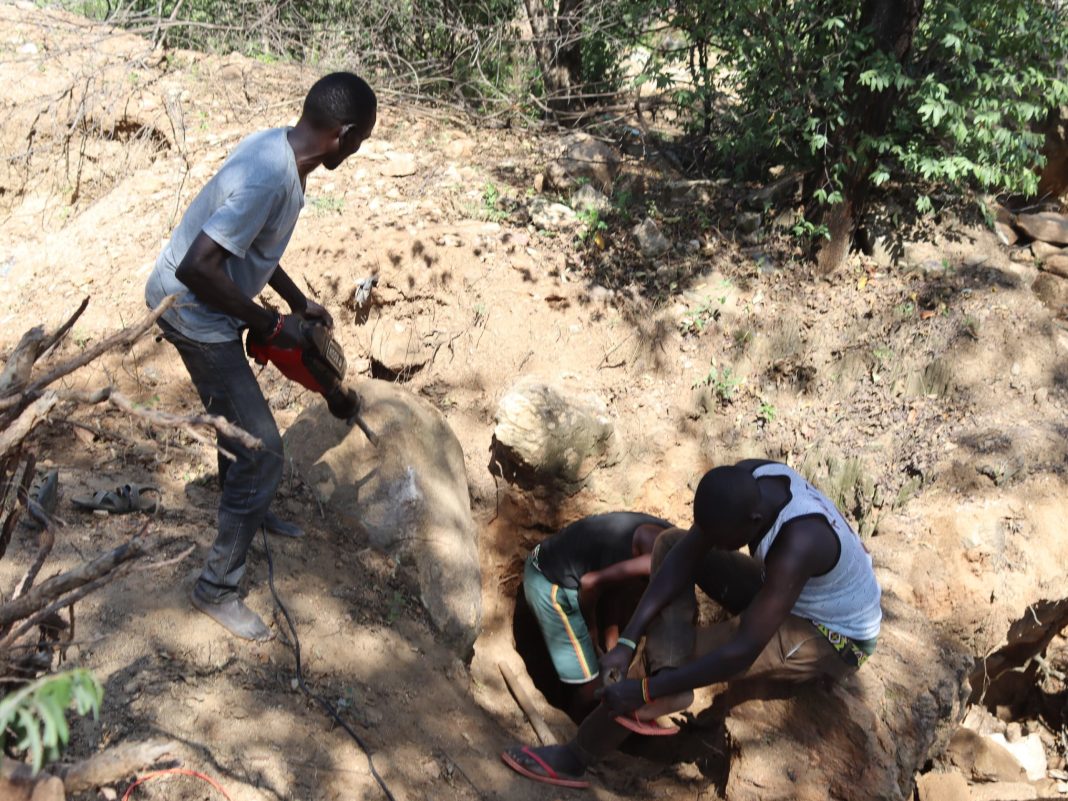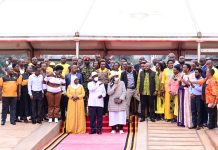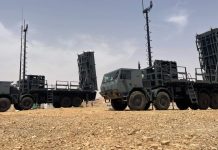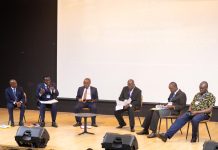By Sarah Mawerere-UBC
Amudat district is one of the nine districts of Karamoja region located in the north eastern part of Uganda.
It is boardering Moroto district to the north, the republic of Kenya to the east, then the Sebei districts of Bukwo and Kween to the south, and Nakapiripirit district to the west. Amudat headquarters is located about thirty eight kilometers north east of Nakapiripirit district. It is approximately four hundred kilometers north east of Kampala capital.
Amudat district has got gold natural wealth. Beneath its surface are deposits of gold that have long been sought after by artisan miners, organized groups and companies. The discovery of gold reserves within the Karamoja region has attracted both local and international miners. In particular, the district of Amudat has seen an increase in artisanal and small-scale gold mining activities over the past few decades.
Mining is one of the four pillars of national development alongside Agriculture, Tourism and Services. It supports livelihoods and provides an alternative to the illegal cattle rustling in this area.
A miner by the name Rose Phepobhiso aged thirty years old, has mined gold around Cheprarat area for almost ten years now using rudimentary ways of digging soil and using a Karaya with Angalia (a local basin that is used to mine and a local hoe) to get gold. “I do it every day as my main activity and I learned mining by seeing others do it”. She noted
Phepobhiso intimated to us that mining gold is not easy as one has to struggle to get it. You can scoop soil in a Karaya basin, take it to the river here for clearing the soil until when you identify the gold. You can even scoop more than two times without identifying a single piece of gold. But you have to continue digging the soil and putting water until when you get some gold”. She adds.
She further noted that in a day, she can get a little measurement of gold that can fetch her something like ten thousand shillings. “This can help me to buy the basic items like vegetables, soap and some sugar. As a woman, i need to struggle so hard to provide for the family, and this is the source of income that I depend on”.
This sector that is providing alternative livelihoods to the locals and making a dollar to international organizations and traders, is a looming environmental degradation. It is contributing to environmental pollution; contaminating local water sources and soil, adversely affecting ecosystems and posing long-term environmental hazards.
The Secretary Local Council 1 Cheptokol Village Joseph Lotilo Korok who guided us around Chepkararat mining area in Amudat, regrets that the community land that used to be for community animal grazing was taken over and now occupied by Evergrande mining industry. Community grazing land is reducing and now the herdsmen move distances to other areas looking for grazing land which has led to conflicts in those areas.
Lotilo added that much as other small scale miners are allowed to mine within this same area, land is destroyed. “There are uncovered pits which are left open in where people and animals can fall into”. He said.
He also said that the nearby river called Moron which was formed and runs between Uganda and Kenya boarder is a seasoned river, but used for washing the soil scooped from up for finding gold. Furthermore, there are so many people who have are attracted to this area for gold mining and trade. They also scramble for the same resources, thereby exerting much pressure on the natural resources here. Some of them have come from Rwanda, Burundi, Kenya, Tanzania, China and from within Uganda like Baganda.
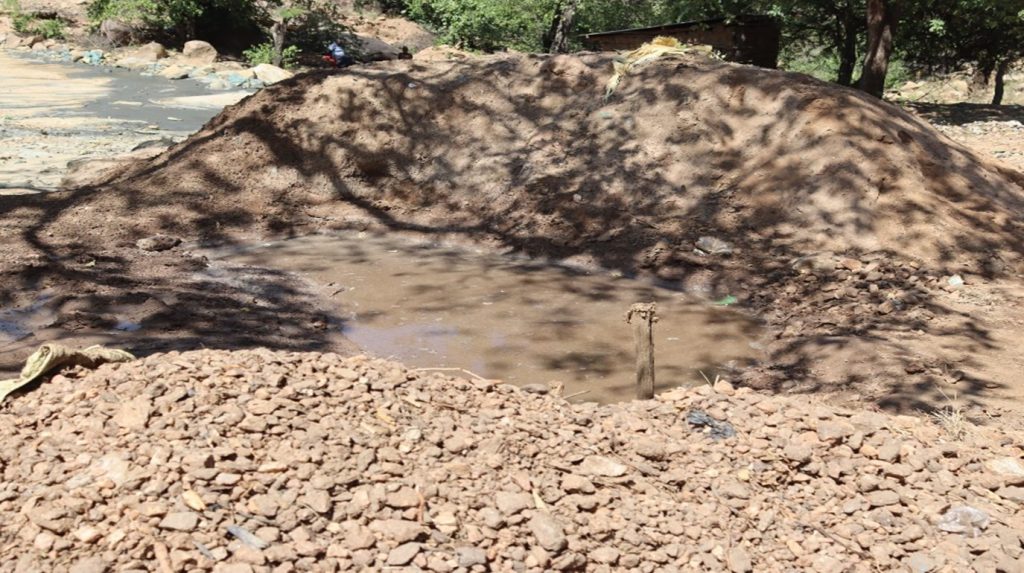
The history of gold mining in Amudat reflects the broader trends in the Karamoja region, where the search and exploitation of mineral wealth has brought both opportunities and challenges to the local communities in Karamoja and Amudat in particular.
Currently artisanal and small-scale gold mining (ASGM) is recognized under the laws of Uganda[1], as one of the ways of supporting the livelihoods of poor communities. However, the practice is one of the major underlying drivers to ecosystem degradation and human health damage owing to the use of mercury and the rudimentary mining methods.
The primary type of mining carried out in the district is artisanal and small-scale gold mining (ASGM). This involves the local communities using traditional gold mining methods to extract gold with the use of simple tools like picks, shovels, and pans to extract gold from the soil. The artisanal and small-scale gold miners (ASGMs) dig into hard rock formations to extract the gold-bearing ore, which is then crushed and processed to extract gold using mercury to amalgamate the gold. Unfortunately, this use of mercury to capture gold drains mercury into water sources; like rivers and wells which people and animals consume. Mercury is a heavy and very toxic metal known for being a neurological toxicant, it poses very significant environmental and health risks.
Besides the use of mercury, the communities in Amudat are also involved in Alluvial Gold mining where gold particles washed down and deposited by water is extracted from riverbeds and floodplains. While gold mining has provided some economic opportunities for many communities within the district; like it has also been in other parts of the country, gold mining has also led to severe environmental degradation in many parts of the district as well as to several social challenges, including water contamination, deforestation, community displacement, human rights violation and several forms of human rights violation.
The informal nature of artisanal mining in Amudat poses regulatory challenges, makes it difficult to enforce environmental laws and regulations as well as the enforcement of safety standards.
[1]The Republic of Uganda: The Mining and Minerals Act, 2022 (Mining and Minerals Act, 2022.pdf)
It is not only Amudat district in Uganda where mining is impacting the environment negatively. In the past, Uganda Radio Network reported that Households in 10 villages in Mahyoro Town Council in Kitagwenda district, accused the Chinese firm Tyang Tyang for polluting River Buhindagi. They said, the company was discharging contaminated water into the river from their gold mines in Kitomi village.
The affected villages were Zambia, Karokarungi, Buhindagi, Omukarere, Kyendangara, Kanyabikyere, Bwetuuma, Kitomi, Kitonzi, and Kachindo. River Buhandigi which stretches from Buhweju district through Ibanda District and pours its waters into Lake George is a source of water for over 2000 residents.
It is a criminal offense to undertake mining without doing environment and social impact assessment to deal with unsustainable mining that can cause biodiversity loss.
In our engagement with the Executive Director National Environment Management Authority (NEMA) Dr. Barirega Akankwasah, stated that there is a need to ensure that mining generates jobs and revenue for the nation, adding that what is needed is sustainable mining that is safe for human health and without environment pollution of soils, water bodies and Air. For example; use of mercury and cyanide in mining was outlawed in Uganda and hence it is an offense to use it.
Dr. Barirega asserted that whoever intends to undertake mining, must conduct an environment and social impact assessment and submit to NEMA. It’s a criminal offense to undertaken mining without doing environment and social impact assessment. Unsustainable mining can cause biodiversity loss,
He said mercury is commonly used in artisanal and small-scale gold mining (ASGM) for gold extraction, but its use poses significant environmental and health risks. He put it that alternatives to mercury in mining focus on safer and more sustainable methods for gold recovery.
The miners and the mining community in Amudat is however aware of the healthy and unlawful practices in gold mining.
Joel Rotich of Loyeye Kadisi village is fifty years old. He has been a miner of gold for ten years and more. He believes that gold mining would be a continuous economic activity for the country, however, the way people carry out the activity would affect the environment.
Rotich said that it is true people used mercury in mining but with a lot of sensitization by Safer World now, a Non-governmental organization on the dangers of mercury and other toxins, many people have refrained from using the chemical. However, since mining is attracting many people from all walks of life, you never know those who are still using the chemicals, including the big sized companies.
Rotich has been appointed the Community Liaison Officer between Ever grant factory that is also doing large scale mining at Chaprarat mining area in Amudat and the community. He advocated for the rights of the local and small scale miners after when there was conflict arising between the Ever grant and the community. When the company needs to expand, I connect the people doing the mining in that area to extend and pave way for Ever grant but the people have to paid money. It is however still not clear how the company decides to extend and give people money. Some people are paid much more than others. It depends on one’s ability to negotiate. It is not clear, we need streamlined measures so to benefit well and to do this better.
Efforts to reach the concerned officers at Ever Grant Company were fruitless as the company site was guarded by security who said we would not be allowed in, and that the bosses of this mining company were not going to talk to us.
When we initially sought support and further guidance with the aim to obtain more information from the Amudat District Environment Officer Mr. Milton Yeko Amutale, he promised to get back to us. It is over time that we have sought reaching him in vain,
Still in Amudat Cheprarat village, is a forty four old woman called Juliana Ilukal who started mining gold about four years ago, she said gold mining is the only economic activity saving people in Amudat and Karamoja in general. It is a free resource and it is for us people here not foreigners. It is ours since it if found here on our land. Much as it is tedious to find gold, we can still struggle to find it to support our livelihoods.
She said that water dries up from the water sources and they move a distance to fetch it in jerry cans to clean up the soil to find gold.
She appealed to authorities to protect the water sources and provide alternative water sources that cannot dry up so that they continue mining since it is the only alternative livelihoods keeping her and others.

The Ministry of Water and Environment acknowledges the significant environmental concerns related to artisanal gold mining in Amudat District.
Senior Water Analyst Department of Water Quality Management Ministry of Water and Environment Otai Abraham Samuel raised the concern that mercury use in gold mining is a significant environmental and health concern and mentioned the dangers of Mercury in Water Sources.
He said that the rivers and streams in Amudat District are vital sources of water for local communities and livestock. Therefore, it is essential to address the environmental impacts of gold mining to protect these water sources.
“We are committed to working with relevant stakeholders, including the Ministry of Energy and Mineral Development, local governments, and communities, to develop and implement strategies that minimize the environmental impacts of gold mining”. He said.
The use of mercury and other harmful substances in gold mining has led to contamination of water sources, posing serious risks to human health and the environment. Otai cited risks like Methylation whereby Mercury in water can convert to methylmercury, a toxic and bio accumulative substance. This accumulates in aquatic organisms like fish, contaminating the food chain. He said human exposure and people consuming contaminated fish, water, or other aquatic organisms are exposed will acquire mercury in their bodies. “The Health effects of mercury exposure can cause neurological damage, kidney problems, and birth defects”. He said
On transboundary Impacts Otai talked about water Pollution explaining that mercury-contaminated water can flow across borders, affecting neighboring countries like Kenya and that fish can migration can migrate to other water bodies, spreading mercury pollution.
He suggested alternative technology solutions technologies for mercury-free gold mining, such as gravity separation or cyanidation.
He emphasized regulations and enforcement in place to be strengthened to prevent mercury use and ensure proper waste management. Also continuous education and sensitization of miners, communities, and authorities about mercury’s dangers and alternative methods. And to have International Cooperation: Collaborate with neighboring countries to address transboundary mercury pollution.
He wound up by calling for remediation efforts to clean up contaminated sites and restore ecosystems.
It is essential to address mercury pollution in gold mining to protect human health, the environment, and transboundary ecosystems. We urge all stakeholders to join us in addressing this critical issue and protecting the environment and water sources in Amudat District. He said
He highlighted some of the measures Ministry of Water and Environment is exploring. These include:
- Promoting mercury-free gold mining technologies to reduce the use of harmful substances.
- Strengthening regulations and enforcement to ensure that gold mining activities comply with environmental standards.
- Conducting regular water quality monitoring to track the impacts of gold mining on water sources.
- Supporting community-led initiatives to protect water sources and promote sustainable livelihoods.
Local initiatives are however being implemented in Amudat district mining areas that aim at sensitizing and educating the communities about the dangers of using dangerous chemicals like mercury in mining gold. Organizations like Safer World, the mining company and community groups have been benefiting from such initiatives.
Rotich Joel is one of the community members who has been identified a liaison person to act between Evergrande factory and the mining community in Cheprarat, Amudat district. Rotich told us that he was encouraged to form a community group of fifteen members with whom he is working to help the community members not to lose out for the mining company to benefit more.
Under their Chomyon Community Group Initiative, Rotich said they advocate for the rights of the community members to also mine a long side Evergrande company. He said through the community group, people are sensitized about the dangers of using mercury in mining gold as a dangerous substance to their health.
Illegal mining in Amudat
After its license expired in 2020, Evergrande Mineral Resources Company Limited was given a License. Later, on May 19, 2021, the company received an exploration license for gold and base metals covering an area of 115.88 square kilometers. On February 14, 2024, the company applied for a mining lease covering 1,250.38 hectares, but as of the time of writing, it had not yet been granted. However, the company has this year (2025) been cleared and permitted to go ahead with mining.
What bothers is that the mined gold does not develop the local community in Amudat. The gold is taken to neighboring countries like Kenya, Tanzania and Rwanda. The locals also testifies that helicopters come directly here and those who trade in gold sell to the big business people and it is flown directly to the airport and flown out of the country. This raises concern of how the area can be restored, when the proceeds that would remain and improve the living conditions of the people flown out.
The 2024 Auditor General Report 2024 shows that Uganda lost about 11 trillion shillings worth of gold to illegal exporters shipped the highly valued mineral without permission from the Ministry of Energy and Mineral Development.
Much as Evergrande Company has been given condition in the new agreement to be filling up the dug holes where gold is extracted, there is the urgent need to set up a mechanism of monitoring to ensure all that is spelt out in the agreement is fulfilled.
More to this, the group is identified for support of better mining methods that can help them to mine and ensure sustainable mining methods. He said this will enable them to continue benefiting from mining and protect the land,
Further information obtained from the National Environment Management Authority is that Government (a combination of the line ministries and departments) will organize artisanal mining and help them to form association in order for them to formalize. And promote to them alternative mining technologies that are affordable and can produce more gold than mercury which is harmful to the human health and environment. They replace use of mercury in gold recovery.
These are among others;
Gravity Concentration
Description: Uses simple equipment like sluices, shaking tables, or centrifuges to separate gold from ore based on differences in density
Advantages
- – No use of chemicals
– Low cost and easy to use in remote areas
– Suitable for small-scale miners
Borax Method
Description: Borax (sodium borate) is used to lower the melting point of gold, allowing it to be separated from other materials without mercury.
- – It is safer for miners and the environment.
- – It is low cost and easy to implement.
Cyanidation
Description: Uses cyanide to dissolve gold from crushed ore; gold is then precipitated using zinc or activated carbon.
- – It is for high recovery rates, even for low-grade ores.
- – Widely used in industrial gold mining.
Although it requires strict environmental controls due to cyanide’s toxicity and expensive and less accessible for small-scale miners.
Eco-Goldex Reagent
Description: A non-toxic gold leaching reagent that replaces mercury and cyanide.
Advantages:
- – Eco-friendly and safe for users.
- – Suitable for both small and large-scale mining.
Challenges: Requires proper handling and technical knowledge.
Chlorination
Description: Gold is dissolved using chlorine gas or hypochlorite solutions.
Advantages:
- – Effective for complex ores.
- – No mercury or cyanide used.
Challenges:
- – Requires specific equipment and technical expertise.
- – Not widely adopted in ASGM.
Flotation
Description: Gold particles are separated using chemicals that cause gold to float in a froth.
Advantages:
- – Effective for sulfide-rich ores.
- – Suitable for large-scale processing.
Challenges: Requires advanced infrastructure and chemical handling expertise.
Direct Smelting
Description: Involves smelting gold ore directly without pre-concentration, often combined with gravity methods.
Advantages:
- – Eliminates mercury use entirely.
- – Suitable for small-scale miners.
Challenges: Energy-intensive and may require access to high-temperature facilities.
The best alternative depends on the scale of mining, ore type, and available resources. Gravity concentration and the Borax method are cost-effective and easy to adopt for artisanal miners, while industrial operations often prefer cyanidation or eco-friendly reagents like Eco-Goldex. Training and technical support are crucial for transitioning to these safer alternatives.


